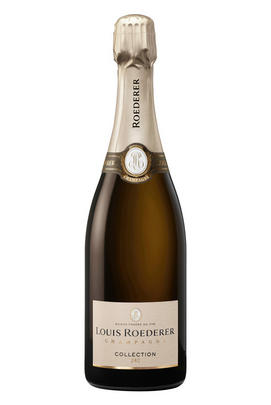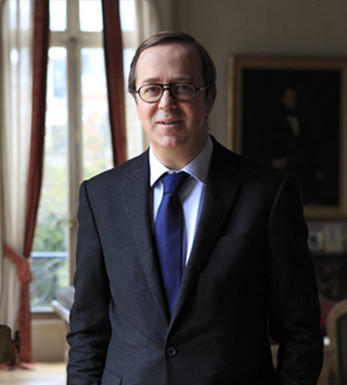
Champagne Louis Roederer, Collection 242, Brut

Critics reviews
The NV Collection 242 is a new wine from Roederer that replaces the Brut Premier in the range. The Collection (which now will be numbered by harvest) is a blend of three components: a perpetual reserve done in the classic non-malo Roederer style, reserve wines in oak with a touch of malo, and a base vintage, in this case 2017. That blend results in a NV Champagne that offers lovely richness and resonance, with plenty of yellow orchard fruit and floral character. Whereas Brut Premier was typically a focused, nervy wine that, while consistently excellent, also was not always in line with the Roederer house style, the 242 tastes more like a Roederer Champagne in terms of its complexity.
Incidentally, there is no Vintage, Cristal or Cristal Rosé in 2017, so all the best lots went into this bottling. Dosage is 8 grams per liter, so lower than the 9 or so that was typical for recent Brut Premier and much lower than the 12-13 that was once customary. The 242 was also bottled with a bit less sugar than the norm, which results in lower atmospheres of pressure in the bottle and silkier texture.
Drink 2021 - 2031
Antonio Galloni, Vinous.com (November 2021)
This debut release is very impressive indeed, wafting from the glass with notes of pear, peach, ripe citrus fruit, toasted almonds, fresh pastry and white flowers. Medium to full-bodied, pillowy and textural, it's concentrated and layered, with lively acids, an enlivening pinpoint mousse and a long, sapid finish. Brut Premier was already a very persuasive wine, but the new Brut Collection nevertheless represents a step up.
Drink 2021 - 2035
William Kelley, Wine Advocate (September 2021)
A completely new approach to NV Champagne. The blend is dominated by wine from the most recent vintage, supplemented with Roederer's 'réserve perpetuelle', a blend of older harvests topped up each year. Serious winey wine that is deep-flavoured, dry and has real personality. A beginning, middle and end. A wine that demands attention. Quite persistent.
Drink 2021 - 2027
Jancis Robinson MW, JancisRobinson.com (November 2021)
A new-format non-vintage that designates the year of the 242nd harvest, 2017, plus reserve wine of 2009, 2011, 2013, 2014, 2015 and 2016.
Aromas of cooked apple, bread dough and lemon tart follow through to a full body with round, delicious fruit and a rich, flavorful finish. Yet, it remains tight and fine with lovely, compressed bubbles. New energy and freshness. Medium-to full-bodied with layers of fruit and vivid intensity. 42% Chardonnay, 36% Pinot Noir and 22% Pinot meunier. 8 grams dosage. Four years on the less.
Drink or hold
James Suckling, JamesSuckling.com (June 2021)
Fresh, vibrant nose displaying aromas of orange, lime peel, almond, honey and brioche with ripe quince and sweet pear undertones. Great focus and length on the palate, seriously harmonious, joyful and unforced.
Drink 2022 - 2040
Matt Walls, Decanter.com (October 2021)
About this WINE

Louis Roederer
Founded in 1776, Louis Roederer is a family-owned, independent Champagne house with a well-deserved reputation for quality. It is managed by Frédéric Rouzaud, the seventh generation to be at the helm.
In 1876, Louis Roederer created the now-famous Cristal at the request of Alexander II. This once intensely sweet wine is now one of the most luscious, deeply flavoured champagnes available, with the '88, '89 and '90 among the greatest Cristals ever released.
Louis Roederer’s best-selling non-vintage blend for almost 40 years, Brut Premier, has recently been replaced by Collection 242. This new multi-vintage blend was created by Chef du Caves Jean-Baptiste Lécaillon in response to increasingly warm vintages. The cuvée aims to capture freshness and is based on a perpetual reserve which focuses on acidity and minerality.

Brut Champagne
Brut denotes a dry style of Champagne (less than 15 grams per litre). Most Champagne is non-vintage, produced from a blend from different years. The non-vintage blend is always based predominately on wines made from the current harvest, enriched with aged wines (their proportion and age varies by brand) from earlier harvests, which impart an additional level of complexity to the end wine. Champagnes from a single vintage are labelled with the year reference and with the description Millésimé.
Non-vintage Champagnes can improve with short-term ageing (typically two to three years), while vintages can develop over much longer periods (five to 30 years). The most exquisite and often top-priced expression of a house’s style is referred to as Prestige Cuvée. Famous examples include Louis Roederer's Cristal, Moët & Chandon's Dom Pérignon, and Pol Roger's Cuvée Sir Winston Churchill.
Recommended Producers : Krug, Billecart Salmon, Pol Roger, Bollinger, Salon, Gosset, Pierre Péters, Ruinart

Champagne blend
Which grapes are included in the blend, and their proportion, is one of the key factors determining the style of most Champagnes. Three grapes are used - Pinot Noir, Chardonnay and Pinot Meunier.
26% of vineyards in Champagne are planted with Chardonnay and it performs best on the Côtes des Blancs and on the chalk slopes south of Epernay. It is relatively simple to grow, although it buds early and thus is susceptible to spring frosts. It produces lighter, fresher wines than those from Burgundy and gives finesse, fruit and elegance to the final blend. It is the sole grape in Blancs de Blancs, which are some of the richest long-lived Champagnes produced.
Pinot Noir accounts for nearly 40% of the plantings in Champagne and lies at the heart of most blends - it gives Champagne its body, structure, strength and grip. It is planted across Champagne and particularly so in the southern Aube district.
The final component is Pinot Meunier and this constitutes nearly 35% of the plantings. Its durability and resistance to spring frosts make the Marne Valley, a notorious frost pocket, its natural home. It ripens well in poor years and produces a soft, fruity style of wine that is ideal for blending with the more assertive flavours of Pinot Noir. Producers allege that Pinot Meunier lacks ageing potential, but this does not deter Krug from including around 15% of it in their final blends.


Buying options
Add to wishlist
Description
It was a brave decision for Champagne Louis Roederer to replace their flagship, bestselling Brut Premier. But Louis Roederer have a reputation for boldness, driven by excellence. In the face of global warming, Chef du Cave Jean-Baptiste Lécaillon has described the challenge of making this Champagne as "fighting for freshness". The style of this wine is a seamless transition from the Brut Premier, with the same drinkability, vinous detail and hallmark quality. Cleverly utilising a new perpetual reserve based on acidity and minerality, Jean-Baptiste has futureproofed the wine's freshness and style. The collection number represents the number of times they have made a multi-vintage since Louis Roederer was established in 1776.
This wine is a blend of Pinot Noir, Chardonnay and Pinot Meunier, from Louis Roederer’s owned Grand and Premier Cru vineyards. It's based on the 2017 vintage, with the addition of special reserve wines held in oak and steel. These have been chosen to add complexity and depth, but also freshness. It's been aged on the lees for at least three years, giving Collection 242 incredible elegance, with a silk-like mousse and notes of red apple and yellow plum. It shows remarkable purity of fruit, with floral highlights and a delicious pain au raisin character. But, as with all of Louis Roederer cuvées, it has an electric chalky freshness which extends the enjoyment of this magnificent multi-vintage cuvée.
Drink 2024 - 2030
Davy Żyw, Senior Buyer, Berry Bros. & Rudd
wine at a glance
Delivery and quality guarantee